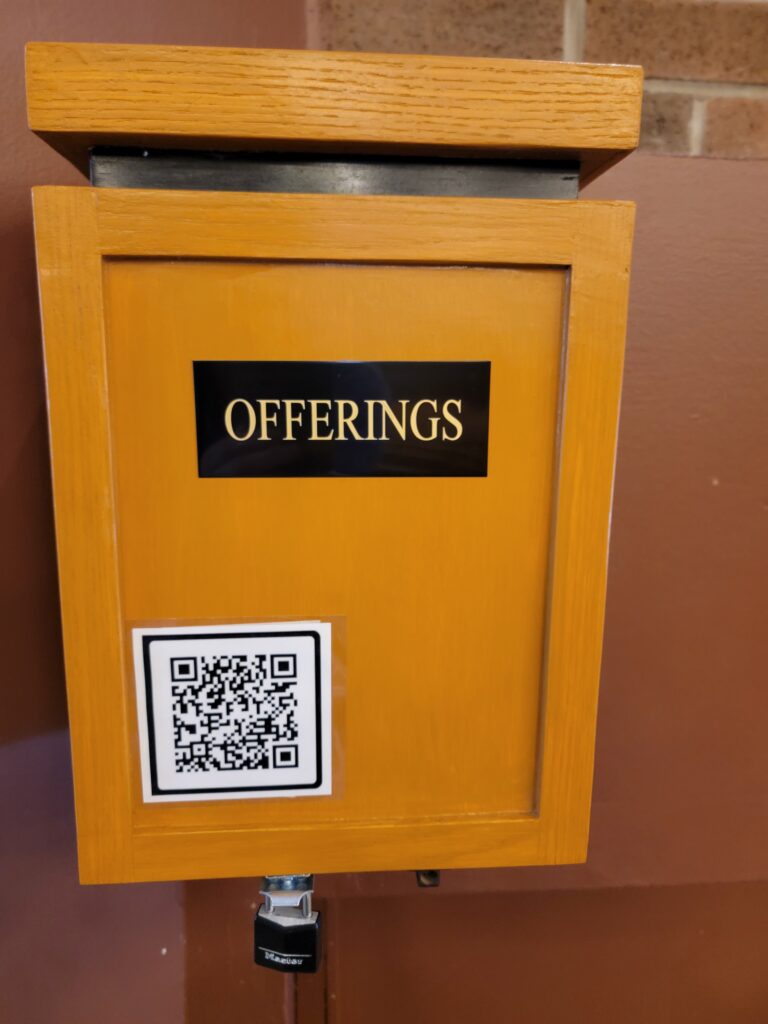
Offerings in a Post-Pandemic Era
How has the “Offering Time” changed in your church in this post-pandemic era we find ourselves? What has changed about the way our congregations give money to the church and its ministries?
The following four (4) questions were posed to a group of fifty-five (55) Deacon Chairs from eight (8) classis in Eastern Canada in the fall of 2023 at various “Deacon Chair Conversations”. These conversations were facilitated by Diaconal Ministries Canada staff and a consolidated summary is what follows here in this article.
We hope this will help your church and deacons as you equip and encourage your churches to live stewardly for the glory of God’s Kingdom!
The Four Questions
- How have churches adjusted to cash and/or cheques not being the primary options to give?
- How can offerings still be a significant act of worship without “passing the plate”?
- How can our offerings still be a relevant teaching moment for the congregation, especially children and newcomers, if we aren’t ‘passing the plate’?
- Has anything changed in the way the offerings are allocated (who churches are supporting)?
#1 – How have churches adjusted to cash and/or cheques not being the primary ways to give?
- Churches now offer multiple digital-based giving options, including website landing pages, e- transfers, pre-authorized debit (PAD), text-to-give, etc.
- Most church websites have a ‘Donate’ option where a person can donate using Paypal, debit/credit card, etc.
- Some churches have done initial experimentation with QR codes and Point of Sale terminals available at a kiosk in the foyer for debit/credit options.
- There are still churches and members who have a strong sensitivity for passing collection plates. The ‘Tap and Give’ mobile app is being experimented with by some as a contactless way to give. (The Salvation Army uses this on street corners). Along the same line, offerings can be deposited in collection boxes that are conveniently located near the exit of the church that most people would file by at the end of the service.
- About 52% (130 out of the 252) CRC churches in Canada use the Bridge App. The Bridge App is available to churches in Canada for $450 CDN per year, although some classis cover it for all their churches. The Bridge App claims that in most cases the ease of using the app actually increases giving. It should be noted that the app offers many other communication features other than facilitating giving options which can be beneficial to a church’s overall communication strategy and enhances congregational life.
- Instead of purchasing printed and numbered ‘giving’ envelopes for the entire membership, some churches are replacing them with plain printed envelopes for the select few that still ask for them (when giving by way of cash/cheque is still preferred).
#2 – How can offerings still be a significant act of worship without “passing the plate”?

- Stewardship happens all week long! It’s important to remind your congregation that we offer our time, talents, and treasures all week long and in a variety of ways…. just like worship is not a Sunday-only thing.
- Consistent and transparent communication every Sunday about the ways to give and regular communication about the church’s ministries and partnerships is crucial.
- Churches must build relationships with the organizations they support – aka partnerships! Encourage members to go beyond financial support. Share stories of hope and change during worship or via newsletters, etc.
- Ensure that there is a significant place in the Sunday morning worship service that is dedicated to the offering. Continue to pray for the offering and the ministries it will support.
- One church does a ‘Giving Liturgy’ every Sunday. The CRC Worship Sourcebook also has good resources for offering liturgies and prayers.
- One church includes the offering as part of their Call to Discipleship at the end of the service; giving is done as you leave the sanctuary and/or during the coming week as members continue their worship through giving their time, talents, AND treasures all week long.
#3 – How can our offerings still be a relevant teaching moment for the congregation, especially children and newcomers, if we aren’t ‘passing the plate’?
Congregation
- Videos are an excellent awareness raising tool if done strategically and appropriately. Many ministries and organizations have well-made videos that can be shown before the service (via emails or on social media pages) or as part of the offering time. Having short and impact-focused is important.
- In the case of local ministries, having a person from that organization share with your church during a worship service builds connection. Most ministries are more than willing to do this!
- Coordinate the offering schedule with the worship themes of the particular Sunday. For example, an offering for Indigenous Ministries might be paired with songs and message references.
- Regarding deacons making offering announcements in front of the church, use a template that helps with determining what to say and encourage deacon mentoring pairs to help ease the anxiety of making presentations.
- Having deacons do the offering announcements during the service in front of the church is a learning opportunity for the deacons themselves, incentivizing them to do research on the causes that the diaconate is supporting.
Newcomers
- Unapologetically communicate that generous giving is a privilege; this communicates to newcomers that this is a part of who we are and what our faith in action looks like.
- The church’s website (or other materials/handouts) can give instructions for setting up regular giving so that a newcomer can easily figure it out. Mentioning this in your weekly bulletin or during the announcements helps as well.
- Have a deacon explain stewardship and financial giving at a New Members class and/or Profession of Faith class.
Children
- In your children’s Sunday morning program, pick a cause to support and encourage children to bring their money in and pray for the ministry (monthly or quarterly). Again, consistent communication with parents is important. Share information on the cause and include ways to pray for them. Even better to support a cause your church already partners with!
- Periodically have offerings that are tangible – that children can touch and see. For example, bringing food items to be given to a food bank or a playpen or diapers for a women’s shelter, etc.
- Some churches use ‘coupons’ or ‘vouchers’ that are purchased from the church in various dollar amounts ($1, $2, $5, and $20). Members can purchase and then let their children deposit the ‘coupon’ in the offering bag/collection box in the Sunday school classroom or where appropriate in their church, according to their preferences.
It’s important to remember… If your church no longer ‘passes the plate’ or you do so after the children have left for Sunday School, etc., being deliberate with teaching and modeling generous giving not only helps the adults and regular attenders, it is also important to equip and encourage the next generation of stewards!
#4 – Has anything changed in the way the offerings are allocated?
Here are some anecdotal examples that were shared amongst the deacon chairs…
- “In my church, we have identified 12 organizations or causes we want to support. We highlight one every month and take offerings for it each Sunday that month. If there is a 5th Sunday, we leave it open and fill it with a pressing opportunity. This way we can really build a bridge between our members and the offering we are highlighting for the month. It raises awareness and personal connection opportunities.”
- “We intentionally divide our offerings into 4 types; local, regional, global, and denominational. We aim to have an equal balance of each.”
- “As a church we just take one offering. We then set aside 10% for the ministries we support. We do this to help model tithing as a church body.”
- “We present the same offering two weeks in a row to give people more opportunity to give, at the same time focusing our partnerships with fewer organizations.”
- “Instead of selecting causes, we choose a theme and then find partners that work in the theme. For example, the theme of ‘homelessness’ can lead you to partnering with an agency like Indwell.”
What’s working in YOUR church?
It was wonderful to see and hear the variety of ways churches and deacons are encouraging and equipping their members in the area of financial stewardship.
We’d love to hear what is working in your church and context! Let us know by contacting Diaconal Ministries Canada at dmc@crcna.org or 1-800-730-3490 or by reaching out to your Regional Ministry Developer.
Does your church need some help with Stewardship?
Our new Stewardship Course is here!
In partnership with Christian Stewardship Services and the CRCNA in Canada, Diaconal Ministries launched an online, self-guided Stewardship Course designed to help deacons increase their churches’ awareness of the Biblical principles of stewardship and help them live those principles out in practical, measurable ways. It not only covers financial stewardship, but also stewardship of time, talents, and trees! (creation care) Gather a team from your church and start the course today!



